Winter Wellness






DECEMBER 2022 | FUTUREOFPERSONALHEALTH.COM The
her
Brec
best
gut health and wellness 02 How to best prepare your home for severe winter weather 07 An Independent Supplement by Mediaplanet to USA Today A Mediaplanet Guide to Staying Safe and Healthy This Winter
”Stargirl” actress discusses
life on set with type 1 diabetes
Bassinger Dr. Megan Rossi o�fers
practices for
Healthy Living 101: What You Shoud Know
Registered nutritionist Jenna Hope works closely with individuals, brands, companies, and the media to help them implement smarter strategies for nutrition.
How does stress affect your digestive health?
Stress can affect our gut health in numerous ways. As our dietary choices can often change in response to stress, we may be more likely to crave foods with higher sugar, higher salt, and higher fat. These foods are often lower in fiber and, consequently, may contribute to changes in bowel movements and gastrointestinal symptoms, such as flatulence and bloating.
Stress can also reduce the amount of oxygen delivered to the gut, which can contribute to bloating and gastrointestinal discomfort. It may also impact the state of the bacteria in the gut, potentially giving rise to more of the pathogenic strains.
Is there a specific type of diet that Americans should follow for the best lifestyle?
Ultimately, the best diet is one that contains a wide range of wholefoods to provide an array of nutrients and phytochemicals. However, the Mediterranean diet is often touted as one of the most nutrient-rich diets. It’s relatively low in saturated fat, high in healthy fats, and packed with good quality proteins and complex carbohydrates.
Do you have tips for people to stay consistent with their diet and healthy lifestyle?
In order to stay consistent with your diet, you need to ensure you’re enjoying your diet and that you’re making it easy. That way, during difficult or busy times, you’re less likely to get sidetracked.
The Importance of Gut Health in Overall Well-Being
Dr. Megan Rossi, The Gut Health Doctor, breaks down the gut-immune axis and what you can do to improve your gut health and boost your overall well-being.
Can you please explain the gut–immune axis to our readers?
We’re all more interested than ever before in bolstering our immunity. Whether it’s staving off the common cold and winter flu, protecting ourselves against the rising incidence of autoimmune conditions, or surviving a global pandemic, we want strong defenses. News headlines are forever proclaiming the next superfood or supplement that’s finally going to give us super-immunity.
However, what we don’t hear often enough is the fact that immunity is powered by the gut. An impressive 70% of our immune cells actually reside in the gut, alongside our gut
microbiota (GM), and they are in constant communication. This is the gut-immune axis.
Are there foods you can eat to boost your gut–immune axis?
One of the best ways we can support our gut-immune axis is by supporting our GM — keeping it healthy with a diverse and plant-based diet. The following foods are filled with key nutrients and phytochemicals to nourish your immune system: walnuts, garlic, sun-exposed mushrooms, firm tofu, carrots, oranges, wheat berries, chia seeds, turmeric, and broccoli.
Do you feel like there is a lot of misinformation regarding gut health in today’s society?
There is a propensity online to share information that is not evidence-backed. For example: ”leaky gut” is not a diagnosis. Everyone experiences temporary gut lining leakiness from
time to time without any health consequences.
The other common misconception is that you need to eliminate foods to ”heal” your gut and have optimal health. For example, gluten is being demonized everywhere, but wholegrains are packed with fiber and studies show they may reduce the risk of several diseases, including type 2 diabetes, heart disease, and colon and breast cancer.
Restrictive diets can actually starve your body, and cutting out foods could be bad for your health. For good gut health, the goal is diversity, not restriction. Eating a diet rich in a variety of plant-based whole foods supports a more diverse and well-functioning GM to support our overall health.
How does taking care of your gut health improve your overall well-being?
Over the past decade, we have made huge leaps in our understanding
of what the GM is and how crucial it is to our overall health. In short, the trillions of microbes that live in our gut are key to pretty much all of our body systems and responsible for everything from weight management to mood, skin hormones, immunity, and much more. To achieve those short- and long-term benefits, we need to nourish our gut microbes, and what they love most of all is an abundant and diverse range of fiber, which you can find in plant-based foods.
What upcoming gut health trends are you expecting in 2023?
Postbiotics, the beneficial chemicals produced by microbes, is an exciting area of research. This concept could pave the way for optimizing our health by utilizing the pharmacy of chemicals produced by our gut bacteria. Our research at King’s College London is also looking to understand whether specific postbiotics may negatively impact people’s gut health. n
READ MORE AT FUTUREOFPERSONALHEALTH.COM 2 DIGESTIVE HEALTH
@MEDIAPLANETUSA @FUTUREOFPERSONALHEALTH
Publisher Sari Karpe, Michael Pena, William du Tertre, Victoria Melland Business Developer Joelle Hernandez, Joanna Tronina, Razelle Amante Managing Director Julia Colavecchia Lead Designer Kayla Mendez Designer Daniel Vega Lead Editor Dustin Brennan Copy Editor Taylor Rice Director of Content and Production Joelle Hernandez Cover Photo Manfred Baumann All photos are credited to Getty Images unless otherwise specified. This section was created by Mediaplanet and did not involve USA Today.
PLEASE RECYCLE
INQUIRIES: US.EDITORIAL@MEDIAPLANET.COM AND US.ADVERTISE@MEDIAPLANET.COM












































































































Trust Your Gut: Let’s Change the Conversation Around Uncomfortable Digestive Symptoms

Most of us would seek medical attention so we can get back to our daily lives. But when it comes to digestive symptoms, millions of Americans are staying quiet due to embarrassment about what goes on in the bathroom. It’s common: a new American Gastroenterological Association (AGA) survey shows nearly 4 out of every 10 Americans stopped routine activities in the last year due to uncomfortable bowel symptoms, including exercising (19%), running errands (17%), and spending time with family and friends (16%). Despite this disruption, many people hesitate
Imagine you have physical pain or discomfort that keeps you from doing something you love, like playing with your children, exercising, or participating in your favorite hobby. Would you raise it to your healthcare provider or suffer in silence?
to speak with a medical professional. One in 3 says they will only discuss bathroom issues if their provider brings it up.
Everybody poops
Let’s get rid of embarrassment around gut issues. These issues are extremely common, with almost 8 out of 10 people in the United States agreeing they experienced a gastrointestinal or digestive concern in the past 12 months.

As a board-certified gastroenterologist, part of my daily practice is helping patients
know what their normal digestive function is and what questions to ask. Reconsider self-diagnosing or medicating, and talk with healthcare providers. We can help — whether it is a combination of lifestyle treatments, medications, other therapies, or dietary supplements.
This is why I’m part of AGA’s Trust Your Gut campaign, helping to educate patients on when — and how — to have these important conversations with their healthcare providers.
Know your normal
Many digestive health problems have the same or similar symptoms, which makes it harder to know what’s causing them. Ask your healthcare provider if you experience:
• Sudden changes in bowel frequency
• Changes in what your stool looks like
• Frequent gas
• Constipation


• Diarrhea



• Blood in your stool
• Sudden or strong stomach pain

Talk to your healthcare provider about your symptoms. If you need one, ask for a referral to a gastroenterology specialist who can help you come up with a treatment plan to improve your daily life. Learn how to Trust Your Gut and get back to enjoying your everyday life. For more resources, visit patient.gastro.org/TrustYourGut n

Rajeev Jain, M.D., AGAF, Board-Certified Gastroenterologist, Texas Digestive Disease Consultants




This is Shams. Shams was diagnosed with colon cancer at 41. Shams wants you to know the signs and symptoms and your family history. • Blood in your stool • Unexplained weight loss • Change in bathroom habits • Persistent cramps or low back pain
For the nation’s largest colorectal cancer event series.
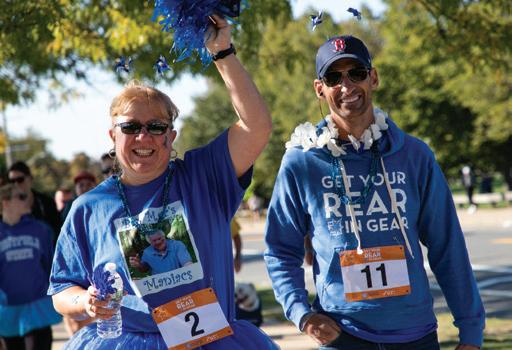
Colon Cancer Signs and Symptoms:

READ MORE AT FUTUREOFPERSONALHEALTH.COM 4 DIGESTIVE HEALTH SAVE THE DATE!
Join us at an event near you!
Celebrate patients and survivors of the nation's third leading cause of cancer.
ColonCancerCoalition.org/Events ���� event dates will be announced soon.
•
• Fatigue • Feeling bloated
Anemia • No symptoms at all
Encouraging a Healthy Gut in Children
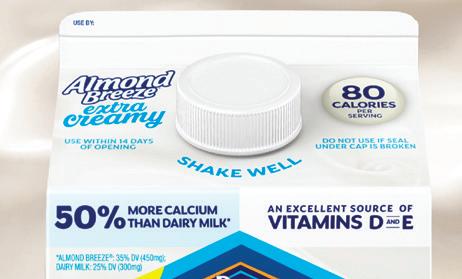
How do gut health and a healthy lifestyle go hand in hand?


Many of the healthy habits that support overall wellness also help bolster good gut health. These include getting enough sleep, eating a balanced diet, and getting regular exercise.
Is there evidence behind a gluten-free diet helping your gut health?


There is no evidence to support following a glutenfree diet to promote gut health. In fact, many gluten-free foods are low in fiber, which is an essential nutrient for gut health.
Does your gut health change when you are a child to an adult? If so, how?



Babies and toddlers don’t have much diversity in terms of gut bacteria — only about 100 species. As children age and experience different illnesses, antibiotics, and
foods, the microbiome changes. By age 3, a child’s microbiome starts to look more like an adult’s and stabilizes to a degree. Life changes, such as puberty, pregnancy, and menopause, also affect the microbiome.
After age 65, the number of microbes decreases, and the











populations become more similar among people.
What do you suggest for new parents looking to help their child’s gut health?




Encourage your child to eat a variety of healthy foods, including fermented foods like yogurt, kefir, kimchi, sauerkraut, and miso. It may seem challenging to get young kids to eat some of these foods, but if you keep offering them, they’ll try them eventually.
What are some healthy and convenient breakfast ideas for children?




You can help your child start their day right with a bowl of yogurt with granola and berries, a smoothie made with kefir, a bowl of oatmeal, or whole grain toast with nut butter. n


MEDIAPLANET 5 DIGESTIVE HEALTH The Best Almonds Make the Best AlmondmilkTM Learn more at almondbreeze.com Plant-based, Lactose-free, Gluten-free, Delicious, and now...
Frances Largemen-Roth, RDN, nutrition expert and author, shares her insights into gut health and how to cultivate a healthy gut microbiome in children.
PHOTO: LAUREN VOLO
Type 1 Diabetes Empowers Me to Do Something Bigger Than Myself
working alongside my fellow T1D co-star Cameron Gellman, aka Housman on “Stargirl.”
The hours we worked were insane and extremely taxing, but having someone on set who understands T1D helped us overcome obstacles. It’s also been rewarding to share our journeys to help educate people and advocate for others living with the disease.
The good fight
and I was horrified. I let him use my meter, and his blood sugar level was dangerously high. Unfortunately, he could not afford his prescriptions; therefore, he hadn’t checked. How could anyone be denied insulin — the very thing we need to live? I was heartbroken, and a fire was lit.

Living with type 1 diabetes (T1D) can be a burden on some days, and it’s much more complicated than most people understand. However, T1D also allows me to do something much bigger than myself.
I have always dreamed of a career in the performing arts, but the journey hasn’t been easy. Diagnosed at eight
years old, I manage T1D while traveling and spending long days on set. Because the disease is still widely misunderstood, I make it a point on my first day, on every set, to share my diagnosis with the director and medic so everyone is aware of what could happen if my blood sugar goes too high or too low. I also routinely keep juice and snacks around for emergencies.
One of my most empowering experiences is
While T1D can sometimes be a burden, I’m fortunate to have a strong support system and access to affordable insulin and diabetes technology to make managing the disease easier. However, I know the need is critical for others who don’t have the same resources.
That’s why I’m super passionate about advocating for federal funding for research and affordable insulin. People with T1D don’t choose to develop the disease, and they should always be able to get what they need, no matter the circumstances. Undoubtedly, having access to insulin and new technologies has improved my quality of life, and I’m determined to do all I can to ensure others get the resources they need to live a full, active life. n
One day, a friend told me he hadn’t checked his blood sugar in four weeks, Brec Bassinger

people living with type 1 diabetes (T1D) in the U.S.
READ MORE AT FUTUREOFPERSONALHEALTH.COM 6 DIABETES To learn more visit T1DIndex.org There
are 1.45M
Actress Brec Bassinger, star of the CW series “Stargirl,” shares how she stays strong in the face of type 1 diabetes and why she’s a passionate advocate for affordable insulin.
PHOTO MANFR E D B A U M NNA
How Homeowners Should Prepare for the Winter Months
Britta Merwin, meteorologist for FOX Weather, shares her advice for homeowners during the challenging winter season.
What are the biggest challenges homeowners face during the winter?
The biggest challenge is having a way to safely and affordably heat their home. Every year we lose people to home fires and carbon monoxide poisoning, all because someone was trying to stay warm. It is never safe to heat your home using your oven or using alternate fuels in a fireplace.
How should homeowners prepare for the snow and ice?
Educating yourself on what your home usually encounters during winter is the first step. The second step is having a plan on how to get through the worstcase scenario, and then you will likely be prepared for the most common brushes with winter weather woes.
What are the most common weather issues you anticipate for wintertime 2023?
We are heading into a La Niña winter, which is a weather pattern dictated by abnormally cooler water in the eastern Pacific Ocean. This pattern usually results in dry conditions in the Southwest, Southern Plains, and Gulf Coast. With drought already building, the dry winter will only lead to bigger concerns into the spring and summer of 2023.
How To Prepare for a Winter Storm
Ginger Zee, chief meteorologist at ABC News, shares her tips for preparing for tough winter weather, no matter where you live.
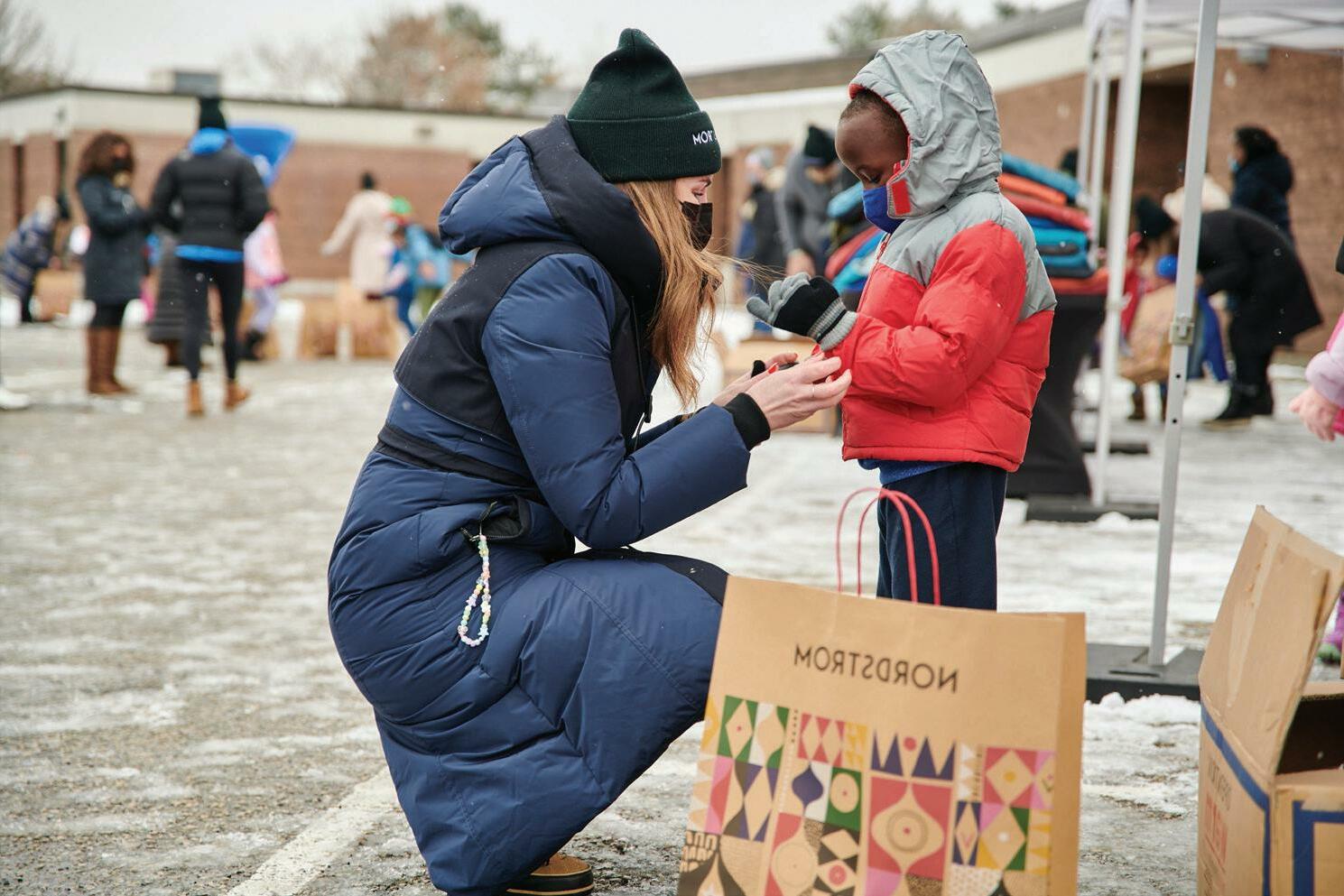
How do you think homeowners can best prepare for the cold winter months?
Since this year’s energy costs are expected to rise almost 30%, I would encourage everyone to take the simple steps to save money and potentially save your life. There are several new programs to get tax refunds thanks to the Inflation Reduction Act. Check out where you can save and prepare for
winter at rewiringamerica.org/ app/ira-calculator.

You also need winter survival gear in your vehicle if you live anywhere that snow and ice can form. When those big ice and snow debacles happen, you need to have food, water, and survival gear (warm clothing, boots, flares, etc.).
What are some extreme weather conditions we can face during the winter?

Winter doesn’t always mean just snow. Freezing rain, for example, falls as rain, but it falls on subfreezing surfaces and freezes on contact, making a glaze of ice. This is where a sidewalk can
become an ice rink and roads can become frictionless in less than an hour.
When it comes to snow, remember that it doesn’t take much to make roads difficult. The National Weather Service has been using a new product the past few winters that warns of lake effect snow squalls — they call it snow squall warning. This is a critical warning to pay attention to; if you are driving, visibility can drop within seconds to nearly zero. Please take these warnings seriously and pull over if you are driving.
Most squalls last only 15-30 minutes.
What are some resources that we can use to make it through a winter storm?
Resources in a winter storm include medications you might need if roads are closed for a few days, food and water to sustain through potential power outages for you and your pets, and a battery-operated or crank radio to keep up with information if devices die. Information is power. There are so many great external battery sources now, so it’s always good to have the ability to get a call out for emergency. The carbon monoxide deaths after a storm like this are too high — being sure you have a battery backup carbon monoxide monitor is key. n
WINTER SAFETY Help provide brand-new winter coats and shoes to children in need.
® ®
Opera�onwarm.org
PHOTO: RAGNAR TH. SIGURÐSSON
Clearing snow from driveways and sidewalks can be hazardous for homeowners. The Snow & Ice Management Association shares best practices for safe shoveling and snow blowing.
Snow: It’s pretty to look at, but if you have to go out in the cold and clear the snow from your driveway and sidewalks, it can be hazardous to your health if you don’t take the proper precautions.

Safe shoveling
Like the snow professionals you see clearing your local grocery stores and hospitals, the first step is to wear the right personal protective equipment (PPE). Dress in breathable layers, avoiding heavy wools and nonmoisture-wicking clothing. Wear quality, outdoor waterproof boots with good traction; a hat; and warm, waterproof gloves. These can help you avoid frostbite and hypothermia from overexposure to the elements.
Once you’re bundled up, stretch before you start and finish shoveling. It might sound silly, but overexertion is responsible for the most common health hazards that happen when shoveling: back and shoulder injuries, broken bones, and, yes, even death. Don’t underestimate the impact shoveling snow can have on your health. You can slip and fall on snow or ice, resulting in broken bones or a head injury. Plus, sudden exertion and the weight of heavy snow can put some people at risk of a heart attack.
Follow these precautions to shovel safely:
• Never try to shovel more than 1-2 inches of snow at a time. Consider shoveling multiple times during a snow event if possible.
• Whenever possible, push
Homeowner Safety Tips for Clearing Snow
snow instead of lifting it.
• Never lift a shovel filled with snow and twist with your back. Always lift with the knees and use your feet to carefully alter direction.
• Take frequent breaks from shoveling and stay hydrated.
Safe snow blowing
If you opt for a snow blower instead of a shovel, don’t be one of the estimated 5,000 people a year who are injured while using a snow blower. Typical injuries are cuts, lacerations, and even amputation. Keep your digits intact with these tips:
• Keep your body behind the handles at all times when operating.
• Always turn off the engine before working on or in the machine. Never use your hands (or any other part of your body) to free an
obstruction — even if it’s turned off.
• Never touch the engine or other mechanical parts of the machine while they’re hot.
• Never blow snow toward pedestrians or cars.
• Wear ear and eye protection along with the PPE mentioned earlier.
Snow clearing might seem like a mundane task, but it can be dangerous. When you’re out in the elements, stop immediately if you experience dizziness, chest pains, difficulty breathing, muscle twinges or tightness, or numb skin (typically fingers, toes, nose, and hands). These are all warning signs that you may be in danger. n

READ MORE AT FUTUREOFPERSONALHEALTH.COM 8 WINTER SAFETY
Cheryl Higley, Director of Education & Content, Snow & Ice Management Association
Severe Pain in the Cold Might Be Raynaud’s
Millions of Americans suffer from a medical condition but don’t know its name: Raynaud’s phenomenon. Despite its prevalence — an estimated 15-30 million people have it (90% being female) — most are unaware that their pain has a medical explanation.
What is Raynaud’s phenomenon?
Raynaud’s is an extreme reaction to cold temperatures or stress. When the body senses danger in this “fight

or flight” situation, blood vessels in the extremities narrow to send blood to vital organs. The most evident sign is white fingers that may turn blue from lack of oxygen and then red as blood vessels reopen.
Medical attention is important to distinguish between primary and secondary Raynaud’s. When secondary, Raynaud’s is part of an underlying, serious disease such as scleroderma or lupus, and it is often the first sign of these disorders. With this less common
secondary form, severe cases can result in permanent blood vessel damage.
Treatments and coping strategies
While there is currently no cure for Raynaud’s, there are treatment options and lifestyle changes that may reduce the severity and frequency of attacks. Oral and topical medications are
clinically proven to keep blood vessels open and may help heal digital ulcers.
In terms of lifestyle changes, the best coping strategy is to know your triggers and be prepared to avoid or protect yourself from cold or stressful situations. In addition, dress for the cold, avoid directly touching cold items, use quick warm-up techniques, and find

products that work for you.
Some patients have success with self-help relaxation techniques, and regular exercise helps increase blood supply to body tissues.
For more information and support, go to www. raynauds.org or call (800) 280-8055. n
MEDIAPLANET 9 WINTER SAFETY
Lynn Wunderman, Founder and Chair, Raynaud’s Association
5 Questions To Ask Your Child’s School To Help Ease the Tripledemic
This cold and flu season especially, not only are the flu and COVID-19 spreading widely, but so is RSV.
To help stop the spread of germs and keep students in school, here are five questions to ask your child’s school about their flu, COVID-19, and RSV prevention policies and procedures:
1. Does the school have a full-time nurse? Many schools do not have a full-time nurse, so all staff should be taught the symptoms and warning signs of the flu, COVID-19, and RSV, as well as what to do in the event of an outbreak.
2. Does the school provide information to families on where to get flu and COVID-19 vaccines?
Vaccines.gov is a free, online resource where users can search for locations that offer immunizations.
3. What is the school’s policy on sick children returning to school?
Health experts recommend children stay home for at least 24 hours after their fever is gone without the use of fever-reducing medicine. A fever is defined as 100°F or higher.
4. How are students educated on how to avoid the spread of germs?
Students and staff should be taught and reminded to stay away from people who are sick; cover their cough and sneezes with a tissue or bent arm; wash their hands often with soap and water for 15-20 seconds; not to touch their eyes, nose, and mouth; and to stay home when sick.
5. How often are germ hotspots disinfected?
Germs can last on some hard surfaces for up to 48 hours. Establish a frequent schedule for cleaning high-touch surfaces to help eliminate germs.
It is important to remember that germs can be transmitted from school to home as well as from home to school. Cleaning and prevention practices at home are just as critical. Together, we can help ease the tripledemic and keep children healthy and learning in school.
5 Ways to Enhance Your Lung Health Through Exercise
When you are physically active, your heart
and lungs work together to supply the additional oxygen your muscles demand. Just like regular exercise makes your muscles stronger, it also improves your cardiorespiratory function. Here are five ways to enhance your lung health through exercise:
1Exercise regularly National guidelines recommend that all adults get 30 minutes of moderate physical activity five days a week. If that is more than you can do right now, any level of activity is better than none, and it doesn’t have to be a formal exercise program to be beneficial. Some examples of moderate activity include walking briskly, recreational bicycling, and gardening.
2
Do aerobic and muscle-strengthening activities
Both aerobic activities and muscle-strengthening activities can benefit your lungs. Aerobic activities like walking, running, or jumping rope give your heart and lungs
the kind of workout they need to function efficiently. Musclestrengthening activities like weightlifting or Pilates build core strength, improving your posture and toning your breathing muscles.
3
Practice breathing exercises
Breathing exercises, like pursed lip breathing and belly breathing, can strengthen your diaphragm and train your body to breathe more deeply and more effectively.
4
Avoid exercising outdoors on poor air quality days
Avoid exercising outdoors when pollution levels are high. When the air quality is bad, walk indoors in a shopping mall or gym, use an exercise machine, or simply turn on the radio and
dance to your favorite tunes in your living room.
5If you are living with lung disease, talk to your doctor
People living with lung disease can and should get regular exercise for all the same reasons as everyone else — your lungs and heart stay stronger, you are better able to perform the tasks of daily living, and you feel better in mind and body. However, if you are already dealing with shortness of breath, it can be intimidating to think about increasing your physical activity. It is important to work with your healthcare team to make a fitness plan that works for you. n
READ MORE AT FUTUREOFPERSONALHEALTH.COM 10 HEALTH & WELLNESS
Anna King, President, National PTA
Albert Rizzo, M.D., Chief Medical Officer, American Lung Association
Exercising and staying active are essential aspects of living a healthy life, and that doesn’t change when the weather turns cold. But studies have shown that people are generally less active during the colder months, and significantly more prone to sedentary behaviors. People tend to gain 1-2 pounds over the winter months, according to the National Institutes of Health, in part because they exercise less.
Increasing physical activity during the winter could have a big impact on our overall health, but there’s little mystery as to why so many of us hibernate instead: The cold makes being outside less pleasant, and makes exercising an uncomfortable and even painful experience.
But there’s an often-overlooked component to our reluctance to go outside during the winter: the clothes we wear.
Buried under layers
The traditional approach to dressing for cold weather activities is to dress in layers: A base layer next to the skin is usually designed to wick away moisture before it can rob us of our body heat, an insulating layer above that keeps the warm air created by our bodies from escaping, and an outer layer protects us from wind and precipitation.
But this approach leads to voluminous, thick, and heavy clothing that discourages activity. Wearing several layers of bulky clothes makes doing anything outside more of an effort than it is during the warmer months. And wearing base layers like thermals all the time — even indoors,
Stay Comfortable and Warm While Moving This Winter With UNIQLO HEATTECH


The conventional wisdom of dressing in layers for winter warmth is being challenged by innovative fabric technologies.
where rising energy costs have prompted many to lower their thermostats and layer on the clothes — can leave people feeling sweaty and overheated.
Advanced fabric technology
Innovative approaches to winter wear are changing this perception of winter as an inactive period, however. Advanced synthetic fabrics make it possible to have clothing that’s not only lightweight and comfortable, but also incredibly insulating. In fact, cutting-edge fabrics like those used in UNIQLO’s HEATTECH line are making it possible to leave layering behind.
The company created more than 10,000 prototypes before perfecting a blend of rayon, polyester, and micro acrylic fiber that is one-tenth the fineness of a strand of hair. The fibers capture the energy of water particles released from the body at the nano level and convert this energy into heat. The result is a single layer that not only retains heat but also
generates warmth, performing as well as — or better than —traditionally layered clothing in terms of keeping you warm and dry in the cold weather.
Since HEATTECH’s creation in 2003, in partnership with Japanese textile manufacturer Toray Industries, UNIQLO has continued to evolve the fabric based on the needs and direct feedback from its customers, providing even further comfort with three levels of heat retention, each designed for different temperature conditions: Regular, Extra Warm (1.5 times* warmer than regular HEATTECH), and Ultra Warm (2.25 times* warmer than regular HEATTECH).
And in addition to inner thermal layers like long sleeve
tops and leggings, UNIQLO has expanded the HEATTECH line to categories such as winter accessories — including hats, touchscreen gloves, scarves — outerwear, warm-lined pants, and its newest product featuring 100% cotton on the inside, the HEATTECH Seamless Ribbed Turtleneck (Extra Warm).
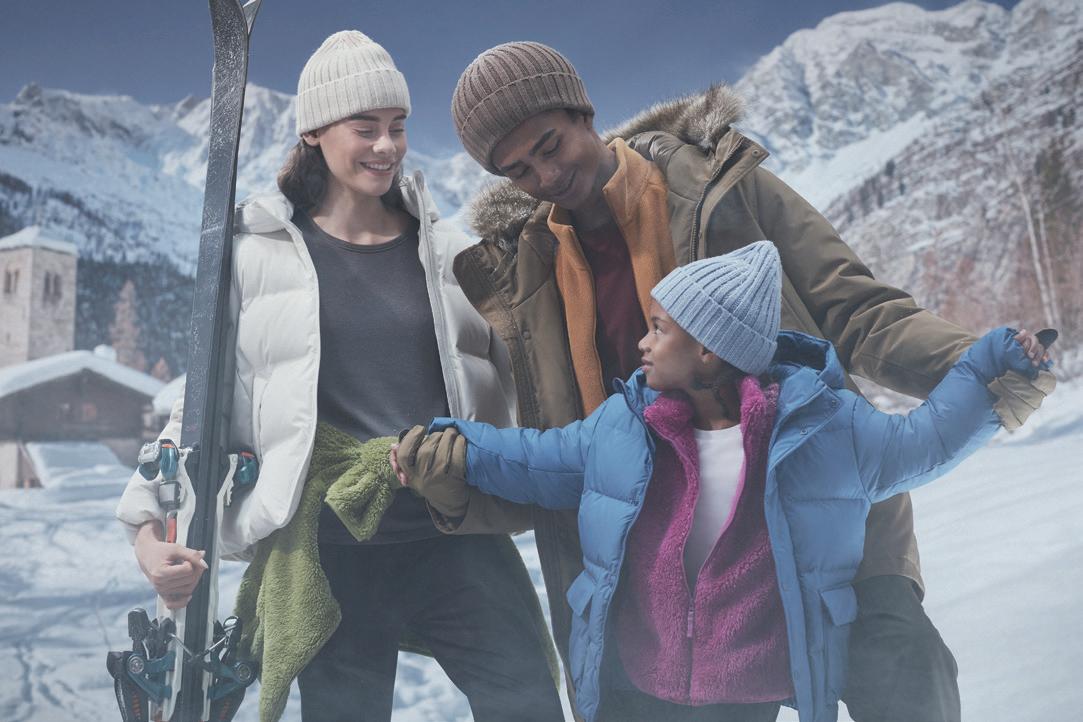
This fabric is lightweight and feels smooth against the skin — and because of its excellent moisture wicking, it even prevents body odor from developing. HEATTECH is available
in a variety of colors, as UNIQLO is known for, offering not just functionality but style — a perfect foundation for your winter wardrobe.
Less bulky clothing can encourage more physical activity outdoors even when it’s extremely cold, and fabrics designed to wick away moisture while trapping heat avoid the discomfort often associated with layered clothing. If your goal is to maintain a healthy level of activity during the winter weather, choosing the right apparel can be a great first step. n
* Based on CLO values, which indicate the thermal insulation of clothing.
Learn more and shop the HEATTECH line at uniqlo.com/us/en/specialfeature/heattech/women

MEDIAPLANET 11 HEALTH & WELLNESS
Jeff Somers
SPONSORED
Getting a Flu Vaccine Can Save Your Family Members’ Lives
“This can’t be happening again.” Those words ran over and over through my mind just a few weeks ago as I sat alone at urgent care watching my 3-year-old daughter fighting the flu.
My worst nightmare was happening again. In 2014, my 3-year-old daughter Cayden died of the flu in a matter of hours. Doctors said my Cady-Bug’s little body was simply overwhelmed by H1N1, a strain of Influenza A.
Now, my daughter Layla was experiencing eerily similar symptoms. It was an overwhelming flashback.

After losing Cayden, my entire family always gets their annual flu shot. We did this in late September, and I credit Layla’s survival to her having received her flu vaccine.
The symptoms between the two girls were very much the same: lethargy, high fever, and an elevated heart rate. I feel lucky that not only did the healthcare providers treating Layla take her symptoms very seriously, but they were also understanding to a mom who was going through the shock of a very sick toddler for the second time.
Flu has been rampant in many parts of the country. Yet despite reports of hospitals being overwhelmed with flu, especially among kids, vaccination rates remain low. The CDC recommends that everyone 6 months and older get an annual flu shot, and my family is living proof of why vaccination is so important.
As we continue into the winter months, I can’t say strongly enough how important it is that anyone who has yet to be vaccinated do so as soon as possible. It might just be the difference in saving a life, as it was for my family.
What Parents and Caregivers Need to Know About RSV

As cases of respiratory syncytial virus (RSV) continue to reach record highs across the country, families need to understand what RSV is, how to prevent it, and when to visit their pediatric healthcare provider.
It is estimated that more than 55,000 children in the United States are hospitalized yearly due to RSV infections. RSV is a virus that causes common cold symptoms, but it can also cause airway inflammation. Although anyone can get RSV, premature infants and patients under the age of 2 are most vulnerable to severe breathing problems due to their smaller airways.
RSV spreads through droplets from coughs or sneezes, making it highly contagious, especially in childcare facilities and schools. To avoid RSV and severe illness in your family, you should wash your hands and clean surfaces frequently, cover coughs, and avoid close contact with sick individuals. If you or your child get sick, stay home. Signs and symptoms of RSV include a runny nose, decreased appetite, cough, and wheezing or difficulty breathing. In very young infants, you may notice irritability and decreased activity, too. Fever doesn’t always accompany RSV.
RSV treatment
If your child is diagnosed with RSV, there are things you can do at home to keep them
comfortable after consulting with your pediatric provider. Make sure your child is getting plenty of fluids, and manage pain and fevers with acetaminophen or ibuprofen as directed. If you have an infant or young child, you may use saline drops and a bulb syringe to clear their nose. You should also monitor your child’s breathing. If your child develops wheezing, labored breathing, or other symptoms that are worsening, seek urgent medical attention. With more serious cases of RSV, patients may need intravenous
fluids, oxygen treatments, or ventilation in rare cases.
Current RSV treatment focuses on supportive measures after the patient is diagnosed, but researchers are investigating innovations in monoclonal antibodies and maternal immunization. These new developments could prevent or mitigate RSV and the dangers it presents, especially to infants and young children. Until long-term solutions are available, be knowledgeable and proactive to keep your family safe and healthy this winter. n
READ MORE AT FUTUREOFPERSONALHEALTH.COM 12 HEALTH & WELLNESS
Jessica Richman, Executive Board Member, Families Fighting Flu
Jennifer Sonney, Ph.D. APRN, PPCNP-BC, FAANP, FAAN, President, National Association of Pediatric Nurse Practitioners
Snuggle and soothe at the same time with Munchkin’s TheraBurpee™ Colic & Fever Rescue Kit.


Specially designed burp cloths use hot and cold therapy for localized treatment. Heat or chill the reusable gel packs for your baby’s comfort. Soft cotton pockets allow for safe application to the chest or tummy.










Relieve fever, ease colic, reduce teething pain, bumps and bruises! Also great for treating nursing mom’s blocked milk ducts.
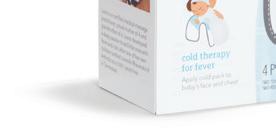


Embrace cold season with a 100% natural fever reliever.





cold therapy for fever

Apply cold pack to baby’s face and chest


hot therapy for colic



Apply hot pack to baby’s tummy

Over 1,500 5-Star Reviews
Available at Walmart, Amazon, and Munchkin.com
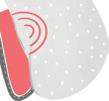
When you need more than a hug to make it better.
Protecting Campus Life From COVID-19 and Flu
Anita Barkin, co-chair of the American College Health Association (ACHA) COVID-19 Task Force, outlines the guidance to colleges on mitigating disruptions from COVID-19 and the �lu.
Over the past three years, COVID-19 has caused a major disruption to college students’ academic experience. Not only were in-person classes replaced with online ones, but internships, group projects, collaborative research, and study abroad programs were unavailable.
The ACHA COVID-19 Task Force has spent the last few years providing guidance to colleges on how to best navigate the challenges of COVID19 to ensure campus life can return to normal.
“Getting vaccinated is the No. 1 strategy for protection,” said Anita Barkin, co-chair of the ACHA Task Force. “The COVID and flu vaccines are safe and effective for preventing serious illness. Even though you don’t get 100% coverage and a guaranteed prevention with those vaccines, we do know that those vaccines are very effective for preventing serious illness from these viruses.”
Vaccine education and accessibility
A key strategy for a highly vaccinated college population is to make vaccines easily available.
“Making it convenient for campus members to access vaccines and testing goes a long way toward getting participation,” Barkin said. “Conducting vaccine clinics on campus is ideal, but if you can’t do that, arrange for your local public health department or a private vaccine service to come on campus and conduct a vaccine clinic.”
The task force’s guidance also suggests looping in all college leaders and health leaders to form a united front on vaccinations.
“Before changes are made in any vaccine requirement, campus health leaders should be consulted in advance and community partners should be engaged, including your local health department, your community-based organizat ions, and local pharmacies,” Barkin said.
A study conducted by ACHA and and the Campus COVID-19 Vaccination and Mitigation Initiative (CoVAC) showed that colleges with accessible vaccinations not only had a higher rate of vaccinated people, but students felt safer on campus.
“As we know, some states have taken positions that hamper the institutions from being able to require or access
vaccinations,” Barkin said. “If you’re a resident of a state that does that, it erodes trust and the motivation to do so. It’s unfortunate what happened with the COVID vaccine on the political side; it was part and parcel of the politicization of the entire pandemic.”
Because of that divisiveness, it falls to colleges to ensure student bodies are properly informed. “In order

to continue to maintain vaccine confidence, you need to make an investment in your educational outreach and convey the importance of vaccination as the best way to ensure a full and robust campus experience,” Barkin said.
Lingering mental health effects



Many of the initial disruptions to college life have been mitigated with vaccinations. However, the long-term mental health effects of the pandemic still cause students anxiety and can also impede their college life.
“There’s a lot of discussion about increased mental health issues in elementary, middle, and high school students, and college students have been impacted pretty significantly as well,” Barkin said. “The message to our campus leaders is obviously the need to put additional resources into mental health, and they are responding. Many schools have provided more resources for mental health counseling of all kinds, both in-person and virtual.”
As schools enter flu season, the importance of the flu vaccine is another concern for students. But Barkin said the great majority of students want to be vaccinated.
“The major reason students would come in and get free vaccination would be because they didn’t want to miss class,” she said. “They committed to the flu shot because they didn’t want to be held up by illness, and I think that is also an important way we can encourage vaccination — you don’t want to miss out.” n
READ MORE AT FUTUREOFPERSONALHEALTH.COM 14 COLLEGE HEALTH
Ross Elliott
Closing the Deadly Meningitis B Gap
Meningococcal meningitis (a deadly swelling of the membranes protecting the brain and spinal cord) is mainly caused by five types of meningococcal bacteria, referred to as A, B, C, W, and Y. Two separate meningitis vaccines are necessary to be fully immunized against the disease, but most children are only vaccinated against the ACWY forms of bacterial meningitis and not against meningitis B. In fact, only 31% of 17-year-olds in the United States received the MenB vaccine in 2021.
Often, the meningitis B vaccine is not required by schools and colleges because of the disease’s relatively low rate of incidence. However, college students are five times as likely as the general population to contract this disease and 100% of meningitis outbreaks on college campuses since 2011 are because of meningitis B. In short, not requiring this vaccine can have deadly consequences.
Alicia Stillman and Patti Wukovits both lost their teenage daughters to the disease, which can manifest with flu-like symptoms that worsen with shocking speed — it can kill an otherwise healthy person within 24 hours.
At the time, the MenB vaccine was not available in the United States to help protect their daughters. “I thought my daughter was fully protected against meningitis because she had received the MenACWY vaccine,” Wukovits said. “I was shocked to learn that she was not.”
Emily & Kimberly
Emily Stillman was a sophomore in college in 2013.
“Emily always made me and everyone else around her laugh,” Alicia Stillman recalled. “She was warm, charismatic, and loved spending time with her family and friends.”
On Jan. 31, 2013, Emily complained about a headache. No one even suspected meningitis. Alicia thought it might be the flu, while Emily blamed an all-night studying session and lack of sleep. When her headache worsened, Emily walked to the hospital with her schoolwork, but her symptoms got worse and worse. By the time her family arrived, she was unconscious, and just 36 hours later, she had died.
Kimberly Coffey was a 17-year-old high school senior who dreamed of becoming a pediatric nurse.


“She loved to sing, dance, and perform in school musicals,” Wukovits said. “Her greatest joy was a sunny day at the beach.”
Kimberly came home one day complaining of body aches and a 101-degree fever. Wukovits contacted their doctor, who advised her to bring Kimberly in for an examination if her symptoms weren’t improved by the morning.
Less than a day later, she was in the emergency room, suffering from intense pain and a purple rash all over her body. Within hours of arriving at the hospital, her organs were failing. She was laid to rest just three days before she was supposed to graduate high school.

Raising awareness
It’s likely that both Emily and Kimberly would be alive today if they had been vaccinated against meningitis B. Stillman and Wukovits founded the Meningitis B Action Project in order to educate parents and students about the disease and the need for two types of meningitis vaccines to help protect against the most common types of bacterial meningitis in young adults.
The speed with which meningitis can advance from initial symptoms to fatality means that it’s very difficult to treat after the fact, making immunization the main line of defense against the disease.
The two women hope they can spare other families the pain they’ve experienced.
“By educating both parents and students on meningitis B, its symptoms, and the vaccine to help stop it,” Stillman said, “we have the ability to save other young people from this deadly but preventable disease.” n
For educational resources and to learn more about meningitis B, visit , meningitisbactionproject.org
MEDIAPLANET 15 COLLEGE HEALTH
SPONSORED
After losing their daughters, two mothers are calling on parents to make sure their kids have received both types of meningitis vaccines.
Jeff Somers
Emily Stillman
Kimberly Coffey











Buy online and ship to store to save 10% www.childrensplace.com Uniform Graphics Active Sleep Denim 1 5 3 4 2 Must-Haves From The Children’s Place 5 5

























































































































































































